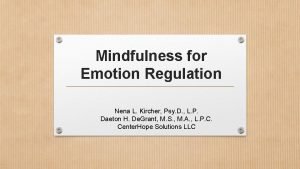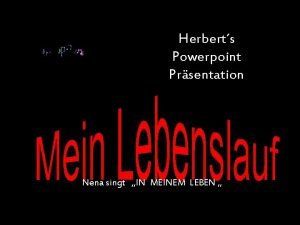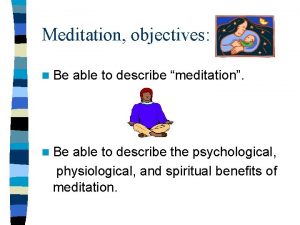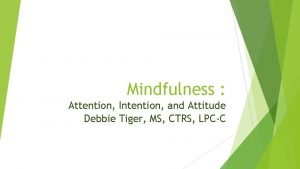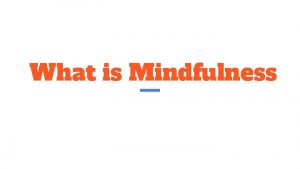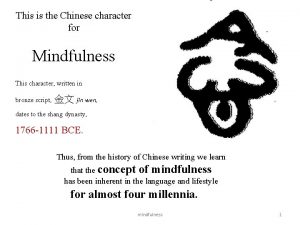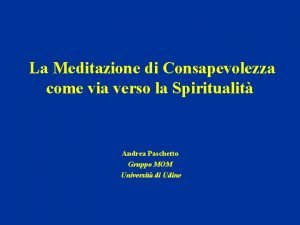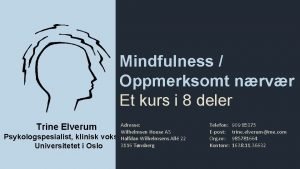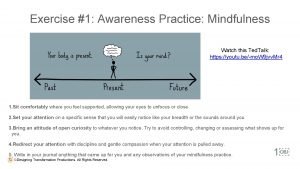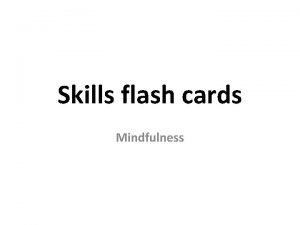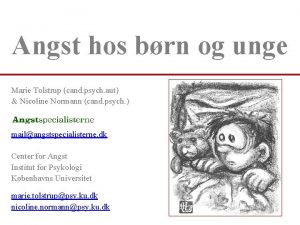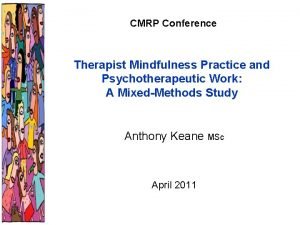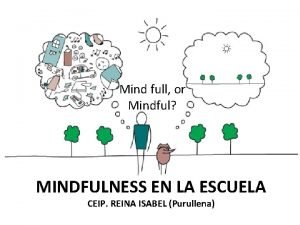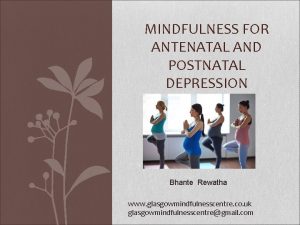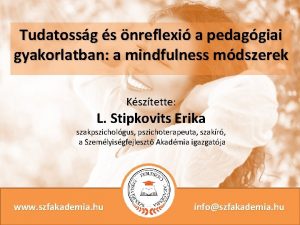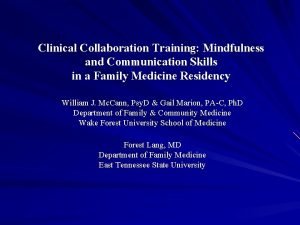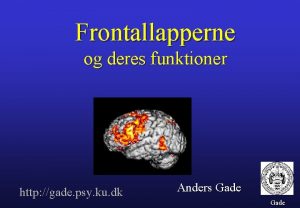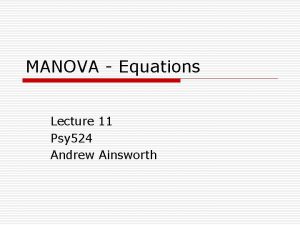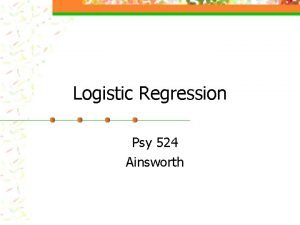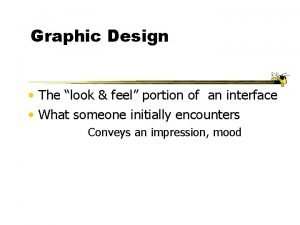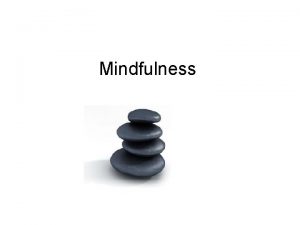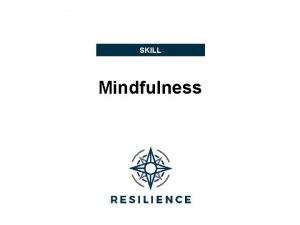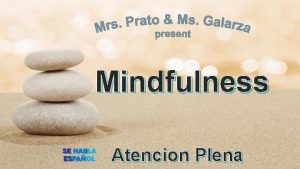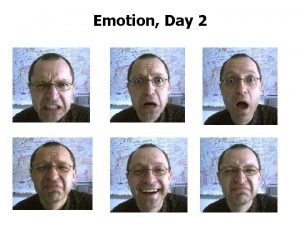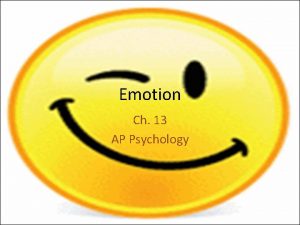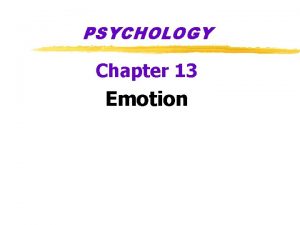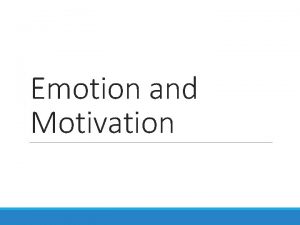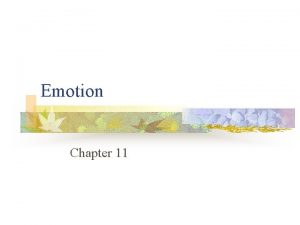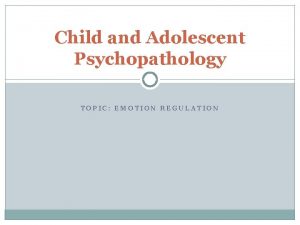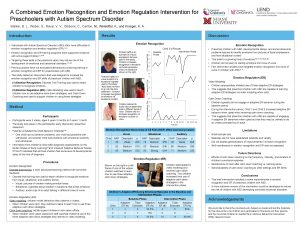Mindfulness for Emotion Regulation Nena L Kircher Psy



































































- Slides: 67

Mindfulness for Emotion Regulation Nena L. Kircher, Psy. D. , L. P. Daeton H. De. Grant, M. S. , M. A. , L. P. C. Center. Hope Solutions LLC

Mindfulness for Emotion Regulation ABSTRACT: This presentation reviews basic principles of Mindfulness and demonstrates how these basic skills can be used to treat patients with a variety of emotion regulation concerns through a combination of lecture and “hands on” skills practice. Emphasis is placed on mindfulness skills beyond basic meditation and visualization to provide options for clinicians to help their clients become invested in these therapeutic techniques. By adding Mindfulness Skills to our clients’ toolkit, we can assist them in managing emotional dysregulation, unhealthy/deviant interests, interpersonal relationships, impulsivity, and unhealthy coping. Attendees of this training will be provided with access to material/handouts they can use with their clients after the seminar. OBJECTIVES: • Participants will be able to define mindfulness in clinical practice. • Participants will be able to describe the utility of mindfulness for management of emotional dysregulation. • Participants will be able to apply at least 2 mindfulness techniques for use with clients’ significant dysregulation. 2

What is Mindfulness? • “Mindfulness is awareness, cultivated by paying attention in a sustained and particular way: on purpose, in the present moment, and non-judgmentally (Kabat-Zinn 2012). § Paying Attention § On Purpose § Right Now § Without Judging 3

What mindfulness is not v. Just Meditation v. A Religious or Spiritual Practice v. A Way to Detach from Reality v. A Quick Fix v. A Magic Bullet v. A Replacement for Cognitive Behavior Therapy 4

Getting Started: Mindfulness for Grounding • Little Tension Releasers #1 (Davis et al 36 -37) • During the day there are many moments when you can benefit from a short time-out. For example, when you catch yourself sighing or yawning. This is generally a sign that you are not getting enough oxygen. Since a sigh or a yawn actually does release a bit of tension, you can practice sighing or yawning at will as a way to relax. Make a conscious effort to sit or stand up straight when you do this. • Sighing • 1. Sigh deeply letting out a sound of deep relief as the air rushes out of your lungs. • 2. Do not think about inhaling—Just let the air come in naturally. • 3. Repeat wherever you feel the need for it. 5

General Benefits of Mindfulness • Changes the physical sensation of pain through • • the production of Endorphins (natural pain killers) Change in the emotional reaction to pain, Fear, Anger, etc. Change in the Thoughts triggered by Pain Improves immune system that may be easily compromised by chronic stress Increases production of the neurotransmitter Serotonin, which can lead to decrease in symptoms of depression (Aguirre & Galen 2013, 51 -51). 6

Mindfulness and Fight, Flight or Freeze Sympathetic vs. Parasympathetic Nervous System • Most people generally operate within the sympathetic nervous system. • You can remember sympathetic as being in sympathy with the individual’s emotions. In other words we are nearly always in fight or flight mode - scanning the environment, worrying about whatever comes next, never truly relaxed. • When the parasympathetic system is activated the heart rate slows, blood vessels dilate, digestion improves, and energy can be stored rather than consumed. (In other words, the body is able to really and truly relax. ) • Mindfulness when used on a regular basis can allow you to switch your body from fight or flight mode into a calmer and more relaxed state that has both immediate and long term health benefits. 7

How Mindfulness Works • Think of the difference between the Hulk and Bruce Banner • If the Hulk is ALWAYS ANGRY then he is ALWAYS stuck in the Sympathetic Nervous System’s FIGHT, Flight or Freeze mode. • On the other hand, Dr. Bruce Banner represents the Calm, Cool, and in Charge of his own emotions Parasympathetic Nervous System. • While it might sound like it would be cool to be the Hulk for a little while, all that being Angry and Smashing things is going to get really Exhausting at some point, which is what happens to us when we spend too much time in fight, flight or freeze mode. • We waste too much energy and we are exhausted and cranky, which compromises our thought processes, ability to manage our emotions and our relationships with people we care about. • Mindfulness can help us have Less Hulk and More Dr. 8

Common Obstacles to Practicing Mindfulness Ø Laziness: You have to make a choice to practice mindfulness. You also have to make a choice to be non-judgmental and move-on when there are days that you forget or become to busy with the static of life. Ø Busy-ness: You need to set aside a scheduled time for your mindfulness practice if it’s going to be a routine. As with all new habits, it’s VERY Easy to be too buys for mindfulness. Remember: Ø Mindfulness requires disciple and a motivation to change. Ø Clients have to make a choice to engage in routine mindfulness practice in order for it to be effect. Ø Like any other lifestyle change this will take time. Ø Disheartenment: The reward of mindfulness is not immediate (and we tend to want immediate gratification). It is easy to become discouraged. Remind yourself why you started practicing mindfulness. (e. g. to manage stress, to improve health, to manage risk, etc). 9

Intense Negative Emotions § Mindfulness can alleviate symptoms of § § § § Anger Depression Anxiety Trauma Loneliness Impulsivity Unhealthy Preoccupation § That may have led to negativity for feeling like the world was against you § This is a great exercise for focus and can be done either in a group setting with the formal instructions on this slide OR can be done by the individual with an “object in my pocket. ” 10

It Begins with the Breath… • While mindfulness is much more than meditation, it still makes sense to start with the basic skill of breathing • Noticing breath is the most basic mindfulness skill and can be useful regardless of your setting from Super-Max Incarceration to Community. • Once your client masters noticing and controlling his/her breath this also becomes a grounding skills for use in triggering or risky situations where escape/avoidance is not an option. 11

Mindful Breathing Exercise ü To Begin Breathe in through your nose to the count of four and out through your moth to the count of eight. ü As you exhale, purse your lips blowing gently as if you were blowing out a candle or blowing a bubble. This will slow down and help you focus the exhale. Instead of letting it out in one big whoosh. If your nose is stuffy it’s fine to breathe in through your mouth. ü Inhale through the nose 1 – 2 – 3 – 4 ü Exhale through your mouth blowing out slowly 1 – 2 – 3 – 4 – 5 – 6 – 7 – 8 ü Repeat this three or four times. ü This is a great technique to practice daily to improve your breath control. 12

More Breathing Exercises • Place a hand on your chest. • As you breathe feel your chest rise and lower. This is commonly how people take their breaths. • Now place a hand on your stomach and inhale until you feel your stomach rise. • Exhale slowly and calmly. Breathing in this manner allows you take in more oxygen, for your body. 13

More Breathing Exercises Tack it to the Wall: • Take a small piece of paper. Hold the piece of paper against a flat surface of a wall. Take a deep breath and exhale slowly, concentrating your breath on the piece of paper thus pinning the piece of paper against the wall. • (Instruct the client do this as long as they can. In a group have all the clients participate in this if able. As the class goes on they this practice more, you can use a heaver piece a paper. This exercise is an excellent way to teach your clients about controlled breathing. ) 14

Exercise: Awareness of an Object • Choose an object that is small enough to pick up and easily hold in your hand. Hold it in one hand pass it to the other hand. Notice how heavy or light it is. How big is it? Rub your fingers over the surface. Are the edges rough or smooth? Observe the shape, color, and texture of the object. Feel any imperfections in the surface or ridges or indentations. Pay attention to whether it feels smooth or rough. Does it feel cool or warm to your fingers? Is it sticky, greasy, slippery, wet, or dry? • Look closely to see if there is anything written on it. Are there words on it? Are there designs drawn or printed on it? If your mind wanders or you start thinking how bored you are, just bring your awareness back to the object? Squeeze it between your fingers. Is it squishy, flexible, hard, or solid? • How does it sound when you tap on it with your finger or scrape it with your finger nail? Does it echo, thud, click, thump, rattle? Rotate it in your hand. How does the light reflect off it? Is it shiny or dull? Does it reflect light, like a mirror? Is the color solid, milky, transparent? Can you see through it? Is it solid or hollow? What material is it made of? • Hold it up to your nose and smell it. Does it have an odor? Is it stinky or fragrant or neutral? Can you drop it on the table? Does it stay still or roll around or teeter in place? What sound does it make as you move it around the table? Does it slide easily or stick in one place? Look closely and find something you didn’t notice before. (Burdick, 94) 15

Basic Skill Set • One of the most hardest parts of practicing mindfulness is not judging your thoughts. • We will have thoughts that interrupt our mindfulness practice. LOTS OF THOUGHTS. • They key is to observe, acknowledge and then let them go without engaging or getting caught up in the thought. Try these three steps as a reminder: 1. Observe thought—Don’t get involved 2. Accept the thought—Don’t judge 3. Let go of the thought—say “not now. ” 16

Refocusing Mindfulness Skills form the basis of meaningful distraction techniques that are more effective than “pure avoidance” of the triggering stimuli ü Through creating a mantra and practicing focusing their thoughts, they learn to manage and refocus deviant thoughts when they arise by using their mantra’s to refocus their thoughts. ü Mindful thinking as illustrated in this exercise and the on the next slide also aid in learning to let go of unhealthy thoughts and of guilt/shame associated with those thinking patterns. 17

Refocusing: Mantras/Wisdom Sayings and Mantras: • Focusing on a word, verse, prayer, or mantra while meditating is a tradition that dates back to ancient India. • While it can be helpful to use a saying or mantra during meditation this takes practice and focus. • Until you’re ready to use a mantra during meditation, you might try writing a quote, verse, word or saying that is meaningful to you and your mindfulness practice on a slip of paper or index card and posting it somewhere that you will see it regularly. • Your “mantra” might represent a goal, idea, or philosophy that motivates you to continue practicing mindfulness. 18 • Mantras also can be used to redirect unhealthy (or deviant) thoughts and set your thoughts to the task at

Mindfulness and the Senses Eating, like breathing, is one of the necessary functions of life. We all do it everyday, but how often do we slow down and think about the process. Not just the process of cooking food or of opening your mouth, shoveling it in, chewing and swallowing, but the real process of tasting food. v Do you pay attention to the color of your food on your plate? v What about the way it smells? Smell is very closely related to taste. v Do you consider foods with certain textures to be more or less appealing? 19

Mindfulness and the Senses • Smell is one of our brains’ most primitive senses. As a result we tend to store memories associated with our sense of smell much more deeply. Think of the smell of your favorite meal cooking or your favorite holiday treat from childhood. Notice how readily it comes to mind. Even if it has been years and years since you last experienced the smell, it will come to you vividly if you allow yourself to focus on it. • Unfortunately, the same is true for smell associated with negative memories or experiences. These memories can also be very difficult to let go of even years after the event. Because these memories are stored on such a primitive level in our brains, they can be quite powerful and even overwhelming if they resurface after we haven’t dealt with them in a while. 20

Mindfulness and the Senses Sense of Smell: • • Take a moment again to think about your favorite smells. There are scents like lavender, mint, and vanilla that are soothing to many people, but think about smells that are particularly calming or soothing for you. Maybe it’s a combination of chocolate and peppermint or cinnamon and nutmeg that triggers a childhood memory; or maybe it’s the perfume of someone that you care about who is far away. We all have smells that trigger these types of memories for us. Take a few moments to think about one of these memories that is meaningful to you. Remember to choose a memory in which you and others are safe and calm. If you do not have a memory that you feel safe to focus on, create one. Create an image of a safe place in your mind. It does not matter whether you are inside or out. If you are creating a place from scratch, it is best to imagine a scene where you are alone. • Immerse yourself in the memory. Begin with the smell, but then gradually incorporate your other senses. As you view the scene through your mind’s eye, what colors are most vibrant and noticeable to you? Are there any sounds? What is the temperature like? Are you sitting, standing, laying down? Be mindful of the surfaces you come in contact with as you build this memory? Scan the image and be mindful of anywhere that the image is unclear and focus on that part until it comes into full focus. • Once you have created the safe space in your mind, begin to focus on your breath. Slow soothing breath. Breathe in the essence of the memory and the smell that is calming and soothing to you. Breathe out the stress, worry, and anything else that you don’t need to be carrying with you. Allow yourself to just sit comfortably in your calm safe place focused on your breath. When your mind wanders, bring your focus back first to the smell and then to the other sensory aspects of the calm safe place in your mind. 21

Mindfulness and the Senses Mindfulness & Taste: Piece of Candy Ø Take your first piece of candy in your mouth. Ø Don’t bite down and don’t swallow it! Ø Just let it dissolve in your mouth. Ø Pay attention to how the taste and the texture changes as the candy dissolves. Ø When your mind starts to wander bring your focus back to the piece of candy in your mouth. • (Rinzler, 15) 22

Mindfulness and the Senses Remember when you were a kid and adults had to scold you not to touch things because they might have germs that could make you sick or they might be dangerous to touch. As humans we seem to be drawn to touch. In a way this makes sense. After all, our skin is our largest organ. We have the ability to take in a lot of information through our sense of touch. 23

Mindfulness Practice: Touch v. Begin by placing your hands together, lining up your palms so that they are pressing together. v. Now slide your hands back and forth against one another for twenty seconds. v. Notice the sensation and the temperature as you rub. v. Stop rubbing your hands together, and for thirty seconds more notice the sensations in your hands. • (Aguirre & Galen 72) 24

Mindfulness skill: Hand Tracing Strong emotions such as anger or arousal is difficult to manage in the moment when one is triggered. Hand Tracing is a simple exercise that can be used anywhere at anytime. Step 1: Call back a memory in which you was angry or could not get focused. Remember how you felt and what your thoughts were? Step 2: Hold one hand in a relaxed upward position. Step 3: Take the index finger of the opposing hand run the figure around your relaxed hand, as if you are tracing your hand. Step 4: As you are tracing in your hand be mindful of how your hand feels, the texture of your hand. Is your hand hot or cold, smooth or ruff. Step 5: Give full attention to your hand closely looking at every line, hair, and wrinkle of your hand. Step 6: Continue the exercise until the intensity of the emotion feels “under control. ” 25

Mindfulness and the Senses Music is often called the universal language. If you have ever played an instrument or sang with a group, you know the joy that can come with being a part of many voices working together in intricate parts to produce the whole composition. Music is present in all cultures and people often have similar emotional responses to a piece of music regardless of where they came from. • ( Burdick, 175 -176) 26

Mindfulness and the Senses Text Analysis: Have you ever been in a class where you were asked to analyze a poem? Thinking about the lyrics of a song is a very similar task. Here are some questions to get you started? v Who is the speaker in the song? v How would you describe him/her v What are the speaker’s emotions? What emotions is he/she trying to v v create in you? What type of imagery is used? What is theme or main idea of the song? Can you sum it up in one sentence? How does it make you feel when you focus on just the words without the music? How does the music change or impact the way a song make you feel? 27

Mindfulness for Grounding Little Tension Releasers #2 (Davis et al 36 -37) Yawning • During the day there are many moments when you • • 1. Open your mouth wide. • • 3. Yawn (loudly if you can). can benefit from a short time-out. • For example, when you catch yourself sighing or yawning. • This is generally a sign that you are not getting 2. Stretch your arms over your head. 4. Repeat as needed. enough oxygen. • Since a sigh or a yawn actually does release a bit of tension, you can practice sighing or yawning at will as a way to relax. • Make a conscious effort to sit or stand up straight when you do this. 28

Mindfulness and the Senses • The image before you is called a Mandala is the Sanskrit word for circle (Cornell 2). These symbols are commonly used in some forms of meditation and were introduced to Western Psychology by Carl Jung. • The Mandala is said to be the “core of reality” or the “true center” of the world that we live in (Cunningham 2). In meditation the Mandala can be used simply as a center to quiet the mind. Notice as you consider different images that the Mandala's pattern seems to radiate outward from the center (Cunningham 20). 29

Mindfulness and the Senses Why Create a Mandala? v Focus for meditation v To Calm and Relax the Mind v The Joy the Creative Process brings, may facilitate psychological healing. v It may make the invisible by expressing thoughts or ideas that could not be expressed any other way. v Mandalas represent the connection and unity between humans and the cosmos as a whole and may help understand this connection. v Creating Mandalas can give an opportunity to express an intuitive piece of the self that is often ignored. • (Cornell 2 30

Mindfulness for Symptom Management • Racing Thoughts • Impulsivity • Overwhelming Emotions • Mindfulness in Relationships 31

Mindfulness for Grounding • What do we mean by Grounding? • Sometimes we find ourselves in situations where we just need to refocus. Maybe we’ve gotten overwhelmed with the bustle of life or maybe we’ve just “zoned out. ” • Grounding exercises help us refocus and brings us back to the present moment. • Refocusing can mean a lot of things. • Refocusing and getting back to work on the task at hand. • Refocusing away from unhealthy thought patterns (and back toward healthy ones). 32

Grounding to Manage Impulsivity § Mindfulness increases the ability for thinking and behaving in a purposeful manner. § Decreasing the likelihood that you will act without thinking § Impulsivity is an issue for a variety of patients who suffer from Severe and Persistent Mental Illness ranging from Personality Disorders to Bipolar Disorder to Severe Anxiety and Others § Using mindful grounding exercises can assist in controlling overwhelming emotions and decreasing associated impulsivity. • The next exercise is useful because you can use it ANYWHERE v In a classroom or meeting v In line at the grocery store v Sitting in your favorite comfy chair 33

General Self-Regulation Ø Everyone experiences intense emotions now and then. RIDE THE WAVE (Aguirre & Galen 102 -104) RIDE THE WAVE is an acronym to help you remember these steps for regulating your emotions. Learning to use these steps will help slow your emotions down, label them, and keep them from becoming overwhelming or out of control. 1. ) Register your body sensations 2. ) Identify your action urges 3. ) Determine the Emotion 4. ) Express to yourself non-judgmentally 5. ) Take deep breaths. 6. ) Hands and body are open. 7. ) Establish a grounded position. 8. )WAVE: Watch And Notice your Emotion as if it were a wave. 34

Instructions for Riding the Wave 1. Register your Body Sensations: One purpose of your emotions is to give you information about what you are experiencing. This happens through sensations in your body. For example, when you get angry, you might notice tightness or pressure in your chest; warmth in your face; clenched hands; or shoulder, back, or neck tension. There are no specific sensations that automatically tell you what emotions you are experiencing, but there are common body sensations for different emotions. 2. Identify your action urges: Emotions are accompanied by an urge to do something. These urges give you more information about what you are feeling. • Remember that just because you are having these urges doesn’t mean you have to act on them. However, learning to identify them is an important part of understanding your emotions. (e. g. Anger: The urge to attack; Sadness: The action urge is to isolate or withdraw; Shame or Guilt: The action urge is to hide). 35

Instructions for Riding the Wave 3. Determine the Emotion: Once you have identified the body sensation and action urge, the next step is simply to name the emotion. Saying, “I am upset” or “I am angry” can help you feel much more in control. Just having a label can provide some relief from the overwhelming sensations. • 4. Express to Yourself Non- judgmentally: Negative judgments can increase the intensity of our emotions. Try saying, “I am anxious” instead of “Oh God, I’m anxious, I shouldn’t feel that way. ” Use the mindfulness skill of noticing and simply label the emotion without any judgment. It may be helpful to think, “I am noticing anxiety” or “I feel an emotion that seems like sadness. ” This creates even more distance between yourself and the emotion allowing you time and space to examine it before acting on it. 36

Instructions for Riding the Wave 5. Take Deep Breaths: As you RIDE THE WAVE don’t forget to breath. Focusing on nice deep belly breaths will also help reduce the intensity of your emotions and keep you from acting too quickly. (Aguirre & Galen 102 -104) 37

Grounding to Manage Impulsivity Focus on your Toes • 1. Identify the feelings that come before the impulsive behavior. Anger and Jealousy are common but it could be different for you. In our example, we will use anger. • 2. As you sit or walk, think about the last time you were very angry, notice thoughts, feelings, and urges that come with this memory. • 3. Now—Shift your attention to your TOES! Move your toes around. Wiggle them. Feel them brush against one another, against your sock, against your shoe. Press your weight against them as you walk or sit. • 4. When your mind wanders back toward the strong emotions or urges redirect your attention toward your toes. (Aguirre & Galen 138) 38

MINDFULNESS WHILE BRUSHING YOUR TEETH • • • Stand in front of the sink. Look at yourself in the mirror and slowly take a deep belly breath and sigh as you exhale. Pick up your toothbrush from its regular place. As you grasp the handle of the toothbrush, pay attention to how it feels in your hand. Is it hard, squishy, warm, cold, sticky, smooth, or textured? Now put the toothbrush under the faucet and turn on the water. Notice how the faucet handle feels on your fingers Is it cool, hot, slippery, smooth or sticky? Is it shiny or dull? Is it covered with drops of water? As the water starts to run into the sink, look at it for a moment. What does it look like? Is it a steady stream? Is it frothy? Is it dripping or rushing out? Is it going quickly down the drain or starting to fill up the sink? Place your toothbrush under the water and notice how your hand feels as the water flows over the toothbrush. Did your hand get wet? What sound do you notice with the water running? Pick up the toothpaste container. Notice how much it weights. Pay attention to how it feels in your hand. Is it warm, cold, smooth, rough? Is it hard, stiff, or flexible? Open the toothpaste container and smell the toothpaste. What do you notice about the fragrance? Is it a fresh smell? Is it minty or some other flavor? • • • Notice how your hand feels on the toothpaste container as you put some toothpaste on your brush. Pay attention to the toothpaste as it glides onto the brush. What color is it? Can you smell it? Notice how your mouth feels as you put the toothbrush into your mouth and start to brush your teeth. Is there a tingling sensation from the toothpaste? Is your mouth full of froth? How do the bristles feel on your teeth? How about on your gums or tongue? Now notice how your mouth feels as you rinse it out with water. Run your tongue around your teeth. Do they feel clean, smooth, sharp, jagged, bumpy, or slippery? Pay attention to how the brush looks as you rinse it with water. Notice how your hand feels as you put the brush and the toothpaste away. Look at yourself in the mirror. Take a deep cleansing breath and smile. 39 • (Burdick, 145) • •

Mindful Communication • Mindfulness skills can improve your ability to: ü Identify Problems and Generate Reasonable Solutions ü Communicate your wants and needs appropriately ü Generally interact with others and build relationships. ü Explain your problems and concerns to others (without losing your head). ü Sort through your thoughts to determine whether or not they are “true. ” 40

Mindful Communication • Intense emotions often muddle communication. v When in the middle of intense emotions it is not only difficulty to understand those around you but it is very hard to perceive empathy from others - even if it is there. • Mindfulness skills can improve your ability to: ü ü ü Identify Problems and Generate Reasonable Solutions Communicate your wants and needs appropriately Generally interact with others and build relationships. Explain your problems and concerns to others (without losing your head). Sort through your thoughts to determine whether or not they are “true. ” 41

Just the Facts Please: Mindful Problem Solving ü Labeling our experiences can help provide clarity. However it is important to stick to the facts without judging. ü Some people use judgments as shortcut ways of describing an experience and assume that others know exactly what they mean. ü For example, if you asked a friend, “How was the special in the dining room? , ” and receive the reply, “It was disgusting. ” You might decide not to order the meal. ü However, if your friend used the Labeling skill of Mindfulness he might have said, “It was a medium rare steak with broccoli covered in blue cheese. ” ü Now it is possible that you might still find it disgusting, but it is also possible that you might think that sounds wonderful! The fact that one person finds something to be disgusting doesn’t make it true for you. ü Labeling clarifies our experiences in the world and makes them more clear and comprehensible to the people we want to communicate with. (Brantley, Mc. Kay 95) 42

Mindful Eating • Choose a meal this week to eat mindfully. Try to practice labeling throughout the entire meal. Begin by using labeling to describe to yourself the experience of sitting at the table. • Use labels and stick to the facts. Don’t call the chair ugly — decide whether it is soft or firm. • • Describe the color of your surroundings. Describe the plate in front of you and the utensils you are using. Next move on to the food on your plate. Take in any smells that arise, and the taste and texture of your food. Do all this quietly in your mind. • Pay attention to the whole experience. When you find yourself distracted by things around you, bring your attention back to noticing and describing your experience during your meal. 43

Judgments and Labels • Judgment and Labels v. Whether Good or bad typically lead to disappointment. v. Judgments can trigger overwhelming emotions. v. Judgments can often lead to disappointment and suffering. v. Judgments prevent you from being truly mindful. v. Often there are times in your life you make judgments that often preset your emotions. v. An examples could include: v. You’re at your home on a Sunday afternoon and you think “I hate Sundays; they are always so boring. ” 44

FLOWING STREAM: Practice Exercise • First make yourself comfortable in your chair. Then if you’re comfortable doing so close your eyes. Clear your mind. • Now, imagine a flowing stream with water lazily going by. As you look closer you notice that there are leaves, twigs, fish and other tiny objects drifting by in the steam. • Imagine yourself standing beside the stream watching these objects float past. Allow your thoughts, feelings, and wishes to float past on the stream with them. Just notice them and allow them to float past without judgement (Burdick, 104). 45

Mindfulness in Relationships § Isolation, Loneliness, and Social Rejection are major areas of concern for this population. § In the long-term these feelings will lead either to anger, callousness and resentment toward others or to anger, self-pity, and despair. § Addressing these experiences is especially important for our clients who have a trauma history these negative or hurtful emotional experiences build on one another like links in a chain so that each new experience activates the hurt from previous traumatic experiences. • Common Diagnoses: Ø BPD Ø ASPD 46

Mindfulness in Relationships • Feeling Misunderstood is one of the most uncomfortable feelings. § It can interrupt our relationship with our treatment team, our family and friends, and our peers or roommates. § Feeling understood also compounds trauma. § A new experience of feeling misunderstood may stir up a memory related to a past time when we felt misunderstood and then we are dealing with the rush of emotions from our current situation and from our past. 47

Mindful Communication You can use the acronym GET ME and the following instructions to refocus yourself when you feel misunderstood. 1. Ground yourself using mindful breathing (focus on your inhalation and exhalation). 2. Express that you need space to figure out the misunderstandings. 3. Think about alternatives to your current understanding of the other person’s position. 4. Maintain an even manner by reminding yourself that everyone is doing the best they can. 5. Express yourself, clearly validating the other person’s view while explaining yours. 48 (Aguirre & Galen 127)

Mindful Communication • Most of us have difficulty simply paying attention to one thing at a time. • In conversation, we focus on what we want to say next rather than just listening to the person who is speaking. • When walking across a crowded room, we scan and make judgments about what other people are thinking or about how we think we look or appear to others. • Mindful Communication skills help us reduce this “noise” in our brains and focus on our relationships and interactions. 49

Being mindful of your relationships Mindfulness in Conversation v We use mindfulness to understand what v When was the last time you hurt v Mindfulness is necessary for us to pick up v How could being mindful have others are trying to say when they communicate with us. on the moment a look flashes across someone’s face and you realize you said something hurtful, even though you didn’t intend to; and would be clueless that you had done it if you were not mindful of the other person’s expression. someone’s feelings by not being mindful in conversation? prevented this incident? v What things would you pay attention to in order to be mindful in a conversation? (Kabat-Zinn 91) v In fact, as we become more mindful of the other person we are involved in conversation with and less focused on our own wants, needs, and thoughts, we may even be able to avoid having made the hurtful comment at all. 50

Being mindful of your relationships • How to help others feel “felt” by you: § § § § Be curious, interested, and open to know the person Practice being mindful of being present with them. Truly listen in an accepting and non-judgmental way. Be willing to be vulnerable and share your feelings, dreams, likes, and dislikes. Guard their secrets, and don’t share them with others unless they tell you to. Help them out when they need help with something (within reason/rules). Repeat back what you just heard the person say to help them feel heard, understood, known, and “felt. ” Take time to know how the person feels by listening when they tell you and by talking with them about their feelings. § Make eye contact. § Give them your undivided attention. 51 (Burdick, 142 -143)

Mindfulness for Letting Go 52

Progressive Muscle Relaxation Find yourself a comfortable position with your feet flat on the floor, arms at your sides, hands resting comfortably in your lap. 9. Take a few deep breaths and pay attention to the sensations of relaxation flowing through your body. 1. To begin, take three deep belly breaths, exhaling slowly each time. As you exhale, imagine that tension throughout your body begins to flow away. 10. Tighten your shoulders by raising them up toward your ears. Hold … and then relax. 2. Clench your fists. Hold for 7 to 10 seconds and then release for 15 to 20 seconds. We will use the same time intervals for all other muscle groups. 11. Tighten the muscles around your shoulder blades by pushing your shoulder blades back as if your were going to touch them together. Hold the tension in your shoulder blades … and then relax. This is another problem area for many of us that may need repeated. 3. Tighten your biceps by drawing your forearms up toward your shoulders and “making a muscle” with both arms. Hold. . . then relax. 4. Tighten your triceps - the muscles on the undersides of your upper arms - by extending your arms out straight and locking your elbows. Hold. . . then relax. 5. Tighten the muscles in your forehead by raising your eyebrows as far as you can. Hold. . . and then relax. Imagine your forehead muscles becoming smooth and limp as they relax. 6. Tighten the muscles around your eyelids by squeezing your eyes tightly shut. Hold… and then relax. Imagine sensations of deep relaxation spreading around your eyes. 7. Tighten your jaws by opening your mouth very, very wide. Hold … and then relax. Let your lips part and allow your jaw to hang loose. 8. Tighten the muscles in the back of your neck by gently tilting your head toward the ceiling. Focus on tensing only the muscles in your neck. Hold … and then relax. Return your head to center. Gently tilt your head downward toward your chest. Hold … and then relax. Return your head to center and then gently stretch to the right. Hold … and then relax. Return to center again and then stretch your head to the left. Hold … and then relax. If you hold a lot of tension in this area you may need to repeat this step. 12. Take a deep breath and hold for up to 10 seconds, slowly exhale. Imagine any excess tension in your chest flowing away with the exhalation. 13. Tighten your stomach muscles by sucking your stomach in. Hold … and then relax. Imagine a wave of relaxation spreading through your abdomen. 14. Tighten your lower back by arching it up. Hold … and then relax. 15. Tighten your buttocks by pulling them together. Hold … and then relax. Imagine the muscles in your hips going loose and limp. 16. Squeeze the muscles in your hips and thighs all the way down to your knees. Hold … and then relax. Feel your thigh muscles smoothing out and relaxing completely. 17. Tighten your calf muscles by pulling your toes slowly toward you. Hold … then relax. 18. Tighten your feet by curling your toes downward. Hold … then relax. 19. Now imagine a wave of relaxation slowly spreading throughout your body, starting at your head and gradually flowing through every muscle group all the 53 way down to your toes. Remember not to rush during this exercise and not to become frustrated with any group of muscles that stores a lot of tension. Notice the tension and then hold. . . and relax. (Burdick, 13)

Letting Go of Unhealthy & Intrusive Thoughts • When you practice mindfulness, thoughts will emerge. This is completely normal. We think about 60, 000 thoughts each day. One of the basic skills of mindfulness is learning how to notice thoughts, acknowledge them, and then dismiss them without engaging them. (Burdick 103) • The pattern goes like this: A. Observe the Thought B. Accept the Thought C. Let go of the Thought—say, “Not now. ” • Remember: § Don’t get involved with the thought; just observe it. § Don’t judge thought or fact that you had the thought. § Accept the thought and dismiss it. 54

Mindfulness for Letting Go • NOTICE, ACCEPT, DISMISS, RETURN (Burdick 61) § Begin by choosing something to focus on: your breath, a mantra, your surroundings, a concept, a task, etc. § Focus your attention on your target. Each time your mind wanders use the following process. Notice thought. Accept it without judgment. Dismiss the thought without engaging in it. Finally, Return your attention back to your target. Repeat this as many times as you need to during your mindfulness practice. 55

Letting Go of Unhealthy & Intrusive Thoughts Mindfulness of Thoughts (Burdick, 106) If you are comfortable doing so, close your eyes. Take a deep cleansing breath in through your nose and out through your mouth. Do it again. Inhale peace and comfort. Exhale tension and stress. Allow your breath to come and go effortlessly. Be aware of the ease with which your breath comes and goes. It is normal while you focus on your breath, that thoughts will come and go in a steady stream. Just notice each thought as it arises. Imagine you are looking at a blank white board in front of you. As you notice and acknowledge each thought, imagine that the thought is being written on the white board in bright red letters. As soon as it is written, imagine that it simply vanishes off the board. Poof. The board is white and blank again. When another thought comes along. Notice it. Write it on the white board and watch it vanish with a Poof. Gone. You let it go. No need to engage with the thought or to judge it. Just notice it, watch it get written on the board, and watch it vanish. Instead of thoughts being written on the board as words, you might imagine thought being represented as a picture. As soon as the picture appears, imagine that it disappears instantly. Do this over and over as the parade of thoughts continues. Enjoy the process of awareness of thoughts followed by their instantaneous disappearance. In between the thoughts, bring your awareness back to your breath, your life force, your energy. Continue this process on your own for the next two minutes. 56

Mindfulness for Letting Go § Another way to remember this is with the Acronym SOLAR § § § Stop Observe Let it Go And Return § The SOLAR exercise is also useful for letting go of unwanted thoughts (e. g. deviant arousal, anxiety, worry, etc). 57

Letting Go of Self Loathing • Self-Loathing or Self-Hatred can be a difficult obstacle to overcome; however, there are mindfulness tools that can help. Try incorporating any of the following phrases into your meditation practice as a way of beginning to offer compassion and caring to yourself: ( Aguirre & Galen, 169 -171 ) • May I be free from danger • May I have mental happiness • May I have physical happiness • May I have ease of well-being • May I be filled with loving kindness • May I be free in my inner core. • May I be peaceful and at ease. • May I be happy. v Remember that Self-Compassion like all mindfulness skills must be developed gradually over time (Aguirre & Galen, 169 -171). v If you still have trouble with this concept, you might try meditating while focusing on the following phrases: “At my core I am basically good”, “ I am worthy of this moment” and “I have everything that I need. ” (Rinzler, 90 - 91). v Finally remember that Self-Doubt like all other thoughts are temporary and given time, these will pass as you continue to grow and move forward (Rinzler 92). 58

Mindfulness & Media • Consider: • How much television did you watch this week? • How much time did you spend playing video games? • How much time did you spend on social media? 59

Mindfulness & Media • Recent research shows an unhealthy trend. As MORE and MORE media becomes available for us to consume we have become Mind. LESS consumers. • We don’t pay attention to what we watch on television • We don’t pay attention to how much me we are spending watching television or playing video games. • We don’t monitor how much me we spend browsing the internet or engaging in social media. • We don’t really pay attention to who we are interacting with when we are playing video games (online) or engaging in social media. • Does any of this sound familiar to you? 60

Mindfulness & Media • When we fall into this Automatic Consumption Pattern related to our Media Use we tend to engage in Poor Problem Solving, are more likely to react emotionally when we are dealing with stress (anger, frustration, despair, etc) and are more likely to feel emotionally exhausted in general. 61

Mindfulness & Media • If you think about it this is really quite logical…if you’re not paying attention you are more likely to make bad decisions. • When we bring this into focus as it relates to media and technology these bad decision can include behaviors ranging from texting while driving to engaging in impulsive web surfing or casual internet browsing. 62

Your Mindfulness Toolbox As we wrap up this group let’s take a minute to review the content that you feel has been most helpful to you. • List your three favorite exercises: • 1. • 2. • 3. • Why did you enjoy these? • What did you get from them? • How could these techniques be useful to you in the future? 63

Things your Clients will complain About Ø Ø Ø Ø Ø I didn’t have time I forgot I can’t stay focused so why should I bother I’m not doing it right, so it won’t help This won’t work for me I fell asleep This is too religious for me. I feel silly doing this. It’s boring I don’t see how this could possibly help me 64

Some Final Thoughts v Every technique will not work for every client. v Even when a your client finds a mindfulness practice they love they’re going to get bored – encourage them to mix it up and practice multiple techniques. v Mindfulness takes Time and Practice but with these two things it does work. 65

References Aguirre, B. , & Galen, G. (2013). Mindfulness for Borderline Personality Disorder: Relieve your Suffering Using the Core Skills of Dialectical Behavior Therapy. Oakland: Raincoast Books. Burdick, D. (2013). Mindfulness Skills Workbook for Clinicians & Clients: 111 Tools, Techniques, Activities & Worksheets. Eau Claire, Wisconsin: PESI Publishing and Media. Cornell, J. (1994). Mandala: Luminous Symbols for Healing, 10 th Anniversary Edition. Wheaton, Illinois: Quest Books. Cunningham, L. B. (2010). The Mandala Book: Patterns of the Universe. New York: Sterling Publishing Company. Davis, M. , Eshelman, E. R. , & Mc. Kay, M. (2008). The Relaxation & Stress Reduction Workbook, 6 th Edition. Oakland, California: New Harbringer Publications Inc. Kabat-Zinn, J. (2012). Mindfulness for Beginners. Boulder, CO: Sounds True Inc. Sage publications. Katie, B. (2002). Loving What Is. New York, NY: Three Rivers Press. Mc. Kay, M. , Wood, J. C. , & Brantley, J. (2007). The Dialectical Behavior Therapy Skills Workbook: Practical DBT Exercises for Learning Mindfulness, Interpersonal Effectiveness, Emotion Regulation & Distress Tolerance. 66 Oakland, CA: New Harbringer Publications, Inc.

Thank you Nena L. Kircher, Psy. D. , L. P. Daeton H. De. Grant, M. S. , M. A. , L. P. C. 417 773 9444 573 705 6670 nenaleann@gmail. com Daeton 27@gmail. com 67
 Nena kircher psyd
Nena kircher psyd Difficulty in emotion regulation scale
Difficulty in emotion regulation scale Nena gify
Nena gify Nena in meinem leben text
Nena in meinem leben text Nena grande
Nena grande Anira significado
Anira significado Ryan nena chc
Ryan nena chc Ang may akda ng nobelang banaag at sikat ay si
Ang may akda ng nobelang banaag at sikat ay si Describe meditation
Describe meditation Miss attitude
Miss attitude Ga toch weg met je mindfulness
Ga toch weg met je mindfulness Langer mindfulness scale
Langer mindfulness scale Mindfulness circle
Mindfulness circle Chinese symbol for mindfulness
Chinese symbol for mindfulness Franco fabbro
Franco fabbro Ruminering definisjon
Ruminering definisjon Ted talk mindfulness
Ted talk mindfulness Mindfulness examples
Mindfulness examples Brainpop precision and accuracy quiz answers
Brainpop precision and accuracy quiz answers Metakognitive øvelser
Metakognitive øvelser Mindfulness
Mindfulness Mindfulness or mind full
Mindfulness or mind full Mbct
Mbct Mindfulness gyerekeknek
Mindfulness gyerekeknek Mindfulness for collaboration
Mindfulness for collaboration Damasio
Damasio Psy2055
Psy2055 Psy
Psy 11 psy
11 psy What is adoloscence
What is adoloscence Psy 226
Psy 226 Industrial organizational psychology ucf
Industrial organizational psychology ucf Psy walsh
Psy walsh Psy
Psy Regression psy
Regression psy Psy
Psy Psy2055
Psy2055 Psy
Psy Sluzobne plemena psov
Sluzobne plemena psov Psy
Psy Psy academy
Psy academy Psy 2055
Psy 2055 Psy sanin
Psy sanin Vzor srdce slova
Vzor srdce slova Psy
Psy Psy
Psy Euro psy
Euro psy Nationell inriktning för artificiell intelligens
Nationell inriktning för artificiell intelligens Sju principer för tillitsbaserad styrning
Sju principer för tillitsbaserad styrning Bat mitza
Bat mitza Nyckelkompetenser för livslångt lärande
Nyckelkompetenser för livslångt lärande Sju för caesar
Sju för caesar Ledningssystem för verksamhetsinformation
Ledningssystem för verksamhetsinformation Handledning reflektionsmodellen
Handledning reflektionsmodellen Borstål, egenskaper
Borstål, egenskaper Centrum för kunskap och säkerhet
Centrum för kunskap och säkerhet Verktyg för automatisering av utbetalningar
Verktyg för automatisering av utbetalningar Särskild löneskatt för pensionskostnader
Särskild löneskatt för pensionskostnader Vishnuismen
Vishnuismen Lyckans minut erik lindorm analys
Lyckans minut erik lindorm analys Inköpsprocessen steg för steg
Inköpsprocessen steg för steg Aktiv exspektans
Aktiv exspektans Strategi för svensk viltförvaltning
Strategi för svensk viltförvaltning Beräkna standardavvikelse
Beräkna standardavvikelse Tack för att ni har lyssnat
Tack för att ni har lyssnat Datorkunskap för nybörjare
Datorkunskap för nybörjare Vad står k.r.å.k.a.n för
Vad står k.r.å.k.a.n för Läkarutlåtande för livränta
Läkarutlåtande för livränta
